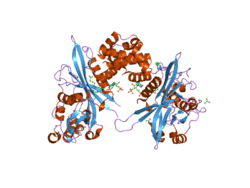HAT1
Histone acetyltransferase 1, also known as HAT1, is an enzyme that, in humans, is encoded by the HAT1 gene.[5][6]
Function
The protein encoded by this gene is a type B histone acetyltransferase (HAT) that is involved in the rapid acetylation of newly synthesized cytoplasmic histones, which are, in turn, imported into the nucleus for de novo deposition onto nascent DNA chains. Histone acetylation, in particular, of histone H4, plays an important role in replication-dependent chromatin assembly. To be specific, this HAT can acetylate soluble but not nucleosomal histone H4 at lysines 5 and 12, and, to a lesser degree, histone H2A at lysine 5.[6]
References
- 1 2 3 GRCh38: Ensembl release 89: ENSG00000128708 - Ensembl, May 2017
- 1 2 3 GRCm38: Ensembl release 89: ENSMUSG00000027018 - Ensembl, May 2017
- ↑ "Human PubMed Reference:".
- ↑ "Mouse PubMed Reference:".
- ↑ Verreault A, Kaufman PD, Kobayashi R, Stillman B (1998). "Nucleosomal DNA regulates the core-histone-binding subunit of the human Hat1 acetyltransferase". Curr. Biol. 8 (2): 96–108. doi:10.1016/S0960-9822(98)70040-5. PMID 9427644.
- 1 2 "Entrez Gene: histone acetyltransferase 1".
Further reading
- Olsen JV, Blagoev B, Gnad F, et al. (2006). "Global, in vivo, and site-specific phosphorylation dynamics in signaling networks". Cell. 127 (3): 635–48. doi:10.1016/j.cell.2006.09.026. PMID 17081983.
- Hillier LW, Graves TA, Fulton RS, et al. (2005). "Generation and annotation of the DNA sequences of human chromosomes 2 and 4". Nature. 434 (7034): 724–31. doi:10.1038/nature03466. PMID 15815621.
- Benson LJ, Phillips JA, Gu Y, et al. (2007). "Properties of the type B histone acetyltransferase Hat1: H4 tail interaction, site preference, and involvement in DNA repair". J. Biol. Chem. 282 (2): 836–42. doi:10.1074/jbc.M607464200. PMID 17052979.
- Gerhard DS, Wagner L, Feingold EA, et al. (2004). "The Status, Quality, and Expansion of the NIH Full-Length cDNA Project: The Mammalian Gene Collection (MGC)". Genome Res. 14 (10B): 2121–7. doi:10.1101/gr.2596504. PMC 528928. PMID 15489334.
- Makowski AM, Dutnall RN, Annunziato AT (2001). "Effects of acetylation of histone H4 at lysines 8 and 16 on activity of the Hat1 histone acetyltransferase". J. Biol. Chem. 276 (47): 43499–502. doi:10.1074/jbc.C100549200. PMID 11585814.
- Marmorstein R (2001). "Structure of histone acetyltransferases". J. Mol. Biol. 311 (3): 433–44. doi:10.1006/jmbi.2001.4859. PMID 11492997.
- Miyamoto N, Izumi H, Noguchi T, et al. (2008). "Tip60 is regulated by circadian transcription factor clock and is involved in cisplatin resistance". J. Biol. Chem. 283 (26): 18218–26. doi:10.1074/jbc.M802332200. PMID 18458078.
- Cheung P, Tanner KG, Cheung WL, et al. (2000). "Synergistic coupling of histone H3 phosphorylation and acetylation in response to epidermal growth factor stimulation". Mol. Cell. 5 (6): 905–15. doi:10.1016/S1097-2765(00)80256-7. PMID 10911985.
- Strausberg RL, Feingold EA, Grouse LH, et al. (2002). "Generation and initial analysis of more than 15,000 full-length human and mouse cDNA sequences". Proc. Natl. Acad. Sci. U.S.A. 99 (26): 16899–903. doi:10.1073/pnas.242603899. PMC 139241. PMID 12477932.
- Kimura K, Wakamatsu A, Suzuki Y, et al. (2006). "Diversification of transcriptional modulation: Large-scale identification and characterization of putative alternative promoters of human genes". Genome Res. 16 (1): 55–65. doi:10.1101/gr.4039406. PMC 1356129. PMID 16344560.
- Grönroos E, Hellman U, Heldin CH, Ericsson J (2002). "Control of Smad7 stability by competition between acetylation and ubiquitination". Mol. Cell. 10 (3): 483–93. doi:10.1016/S1097-2765(02)00639-1. PMID 12408818.
- Galey D, Becker K, Haughey N, et al. (2003). "Differential transcriptional regulation by human immunodeficiency virus type 1 and gp120 in human astrocytes". J. Neurovirol. 9 (3): 358–71. doi:10.1080/13550280390201119. PMID 12775419.
- Harrington JJ, Sherf B, Rundlett S, et al. (2001). "Creation of genome-wide protein expression libraries using random activation of gene expression". Nat. Biotechnol. 19 (5): 440–5. doi:10.1038/88107. PMID 11329013.
This article incorporates text from the United States National Library of Medicine, which is in the public domain.




